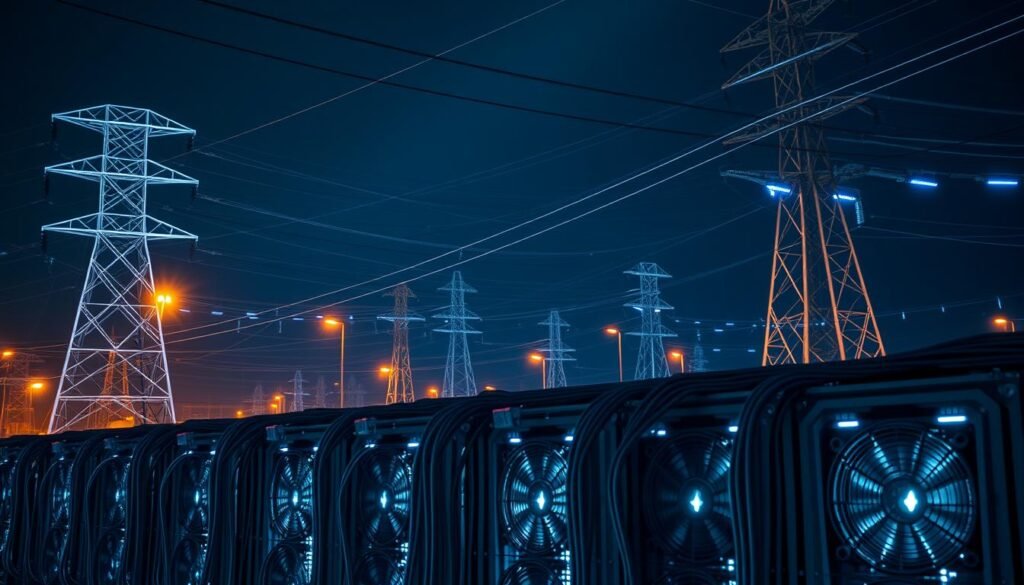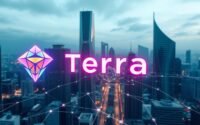Crypto-Mining-Profitability-How to Make Money with Mining in 2022
Surprising fact: in 2025 miners still take home roughly $20 million in bitcoin per day across the network, down from about $63 million per day in March 2024.
This introduction explains why that gap matters for anyone studying bitcoin mining. The block reward was cut to 3.125 BTC in April 2024 and blocks aim to appear roughly every ten minutes. That change reshaped profitability and the work miners do.
Mining costs are real: ASIC hardware, electricity and cooling dominate expenses. Pools and larger operations often win scale advantages with lower fees and better power deals. Still, disciplined smaller setups can find a way to compete.
This article previews the path forward: understand the process, model rewards and costs, pick hardware, manage energy, choose a pool, and plan for swings in bitcoin price and network difficulty.
Key Takeaways
- Mining is competitive; reward and fee income must cover electricity and overhead.
- Block rewards are now 3.125 BTC and blocks target ~10 minutes.
- ASIC costs and power contracts strongly affect net returns.
- Pools and scale often lower fees and improve outcomes.
- Plan for price and difficulty swings when judging profitability.
Understand Today’s Mining Landscape before You Start
From CPU tinkering to hyperscale farms, mining is now an energy- and capital-intensive industry.
Key shifts moved the hobby into professional operations. Early CPU and GPU setups gave way to ASIC and FPGA machines that dominate bitcoin mining today.
Scale, hardware, and power
Network hashrate rose fast, and difficulty climbed with it. That forced miners to use more efficient gear and chase lower electricity and cooling costs.
Who captures most revenue
Large operators win by securing industrial power contracts, lowering fees, and rotating hardware quickly. At the network level, daily revenues remain in the tens of millions of dollars, but distribution favors well-capitalized bitcoin miners.
- Regulation and taxes shape where operations locate and how they run.
- Procurement lead times and failure rates affect uptime and costs.
- Small miners can still join via hosting and pooled services, but run conservative payback models.
crypto-mining-profitability-how-to-make-money-with-mining-in-2022
Older how-to guides still teach the mechanics, but the financial math needs updating for today’s network.
Update the basics: the block reward fell from 6.25 BTC to 3.125 BTC after April 2024. That change halves issuance-based revenue per block and forces different payback assumptions for hardware and hosting.
Align 2022 guidance with current realities
- Replace 2022 reward values in calculators with 3.125 BTC and current difficulty to get accurate revenue per TH/s.
- Remember the Dec. 5, 2024 price spike above $100,000 on some exchanges; price swings change payback timelines but are volatile.
- Higher network difficulty and rising hashrate compresss revenue per unit of work, making efficiency and low power costs decisive.
- Fee spikes can boost miner income temporarily, but relying on them is risky—model steady-state fees and worst-case scenarios.
- U.S. miners must track mined coin value at receipt for taxes; use crypto tax software and keep precise records to measure after-tax profitability.
Practical way forward: benchmark your setup against live revenue-per-TH/s charts, join reputable pools, negotiate power or hosting rates, and plan liquidity for operating expenses during drawdowns.
How Mining Works: Blocks, Hashrate, Difficulty, and Rewards
At its core, mining is repeated trial-and-error hashing that produces a new block roughly every ten minutes. Miners package transactions into a candidate block and run hashing software that adjusts the nonce until the hash meets the network target.
From target hash and nonce to a new block every ~10 minutes
Mining software iterates the nonce and, when needed, an extra nonce to expand the search space. This allows trillions of attempts per second across modern ASICs. When a valid bitcoin block is found, it propagates and the miner collects the reward and fees.
Network difficulty adjustments every 2,016 blocks and why it matters
Difficulty retargets every 2,016 blocks to keep block time near ten minutes. Higher network hashrate raises difficulty, meaning more computational work is required per block. On Dec. 5, 2024 difficulty was near 102.89T, underscoring how competitive the process is.
Block reward, transaction fees, and the role of miners
The current block reward is 3.125 BTC post-April 2024, plus transaction fees included in each block. Miners verify transactions, deter double-spending, and secure the blockchain. Energy consumption and efficient thermal design are key operational factors.
| Unit | Example Device | Typical Hashrate | Typical Power |
|---|---|---|---|
| TH/s | Mid-range ASIC | 50–200 TH/s | 1,200–3,500 W |
| PH/s | Hashroom rack | 1–10 PH/s | 10–50 kW |
| EH/s | Network total | 200+ EH/s | MW+ at scale |
| CPU/GPU | Legacy miners | 100–500 W |
Calculate Profitability the Right Way
Start by plugging real-world inputs into a clear model so you can see daily cash flow and risks.
Critical inputs: list your machine hashrate, watts per TH, local electricity rate, pool fee, uptime, repair reserves, and the current bitcoin price with the 3.125 BTC reward. These values feed every projection.
Revenue math per TH/s
Revenue per TH/s = (your TH/s ÷ network TH/s) × blocks per day × (3.125 BTC + expected transaction fees) × bitcoin price.
For PPS+ pools, payouts reflect your share of expected blocks per day minus the pool fee. That makes settlement predictable but still tied to network share and difficulty.
Electricity and operating costs
Daily electricity = watts per TH × total TH × 24 ÷ 1000 × $/kWh. Compare that to daily BTC revenue to see net cash flow.
CapEx vs OpEx: include hardware payback, hosting, downtime, and service costs. A true breakeven adds repair reserves and conservative uptime assumptions.
Guardrails and risk
- Define a turnoff price where revenue no longer covers electricity and fees.
- Re-run models after each difficulty change—higher difficulty lowers revenue per TH/s.
- Keep cash for electricity and maintenance to avoid forced sales when the bitcoin price falls or fees spike.
Choose Energy-Efficient Mining Hardware
Modern bitcoin miners must weigh upfront cost against long-term energy use.
ASIC vs GPU: why ASICs dominate Bitcoin mining.
ASICs deliver orders-of-magnitude higher hashrate and far better energy efficiency than GPUs for SHA-256 work. That makes GPUs impractical for serious bitcoin mining today. Most operators use ASICs to stay competitive as difficulty rises.
Price per TH and watts per TH: twin selection pillars.
Compare price per TH against watts per TH. Low CapEx looks attractive, but high wattage raises daily power costs and cuts margins.
For example, premium units near ~16 J/TH and ~300–400 TH/s cost more up front but lower ongoing energy costs, improving lifetime profitability.
Longevity, failures, and U.S. sourcing realities
Longevity and serviceability matter. Better-built machines reduce downtime and repair spend. MicroBT units have been noted for comparatively lower failure rates, which helps uptime planning and spare-parts stocking.
U.S. miners face batch shortages, long lead times, and risks on the used market. After-sales support and warranty coverage can make or break deployments.
- Hosting costs: low hosting rates can make price-per-TH the priority; high rates shift focus to efficiency (watts per TH).
- Supplier mix: diversify vendors and train technicians to cut service delays.
- Upgrade plan: anticipate difficulty growth and resale options for older gear.
Control Electricity and Cooling Costs in the United States
Power pricing and thermal design are the two biggest levers for any American miner. A handful of cents per kWh can decide if a rig runs profitably or loses cash.
Residential vs industrial rates and why home setups usually lose money
Typical U.S. residential electricity near $0.12/kWh often creates negative returns for small miners. Industrial contracts at or below ~$0.05/kWh unlock viable operations and longer payback periods.
Low-cost power strategies: colocating, flare gas, and renewables

Colocation gives access to bulk rates, professional maintenance, and better cooling than a garage. Flare gas projects capture stranded energy at oil sites and can drop power costs dramatically while cutting emissions.
Renewable PPAs or on-site solar/wind can stabilize price exposure. But curtailment, seasonal output, and uptime planning matter for miners who must protect daily revenue from the network and block timing.
“Evaluate the all-in kWh cost, including demand charges and seasonal swings, not just the headline rate.”
- Cooling and energy consumption scale with density—plan rack layout, airflow, or immersion carefully.
- Permit, grid, and community factors can limit large draws; secure contracts before scaling.
- Monitor difficulty and price continuously and retire inefficient units when margins flip.
Join the Right Mining Pool and Optimize Payouts
A miner’s payout model starts with the pool; that choice shapes daily cash flow.
Pick a reliable mining pool with clear stats, strong uptime, and low orphan rates. Long-running pools like Slush Pool and F2Pool offer transparent dashboards that help audit expected versus actual payouts.
PPS+ pays daily for block rewards and transaction fees and usually charges around 2.5–4% in fees. That predictability helps with cash management. Other methods, like PPLNS, can swing with luck and block timing.
| Payout Method | Typical Fee | Predictability | Best For |
|---|---|---|---|
| PPS+ | 2.5–4% | High | Operators needing steady daily cash |
| PPLNS | 1–3% | Variable | Small miners tolerating variance |
| Solo/Hybrid | 0–2% | Low (high variance) | Large or strategic miners |
Fees cut into net rewards, so balance price against reliability. Miners should use failover pools, correct stratum endpoints, and alerting to avoid downtime. Many pros sell via OTC desks to reduce exchange slippage and selling fees, which raises realized returns.
“Audit payouts against expected hashrate regularly to spot issues fast.”
Halving, Market Cycles, and Risk Management
The April 2024 halving cut the block reward to 3.125 BTC, forcing miners to tighten margins and sharpen strategy.
Immediate effects and long-term adjustments
The reward reduction lowered issuance per new block and increased pressure on smaller operators.
To stay viable, many miners upgraded hardware, lowered energy costs, or leaned on fee markets and price appreciation.
Price, difficulty, and fee dynamics
Price rallies attract hashrate, which raises difficulty and reduces revenue per TH/s over time.
Fee spikes can temporarily boost income, but they are unpredictable and should not be the base case in models.
Risk management and scaling decisions
Hedging power costs and forward-selling future production are common professional tactics. Maintain cash reserves and fixed-rate power where possible.
Regulatory shifts—energy taxes, bans, or permit limits—can change costs quickly. Diversify sites and energy sources to limit localized risk.
- Professionals use bulk procurement, OTC liquidity, and financial hedges to survive drawdowns.
- Amateurs should test downside scenarios, set turnoff thresholds, and avoid overleveraging.
- Continuous efficiency gains in hardware and power sourcing make fewer coins per block manageable.
“Scenario-plan for price, difficulty, and fees; discipline in expansion and hedging captures upside across cycles.”
Conclusion
Conclusion
End with a clear plan: bitcoin mining can pay when efficient mining hardware, low electricity rates, and a smart pool strategy align with current network conditions.
Use live calculators that include the 3.125 BTC reward, difficulty, power price, and expected transaction fees before you deploy capital. Model price and difficulty scenarios and include all costs like hosting and maintenance.
Improve outcomes by choosing efficient hardware, securing cost-effective power, joining reputable mining pools or bitcoin mining pools, and managing selling and pool fees. Treat mining as a business: track uptime, J/TH, realized payouts, and e-waste plans.
Miners face market and regulatory risk. Build cash buffers, phase deployments, and keep learning about crypto infrastructure, firmware tuning, and energy strategies to stay competitive and responsible.
FAQ
What factors determine whether mining is profitable in 2025?
Profit depends on hashrate, power draw, electricity cost, pool fees, bitcoin price, and network difficulty. Capital expenses for ASICs and ongoing operational costs like cooling and maintenance also matter. Calculate revenue per TH/s, subtract energy and pool fees, and include device depreciation to see true profit.
How does the April 2024 halving affect miner revenue?
The halving reduced the block subsidy to 3.125 BTC, cutting miner base rewards in half. That makes transaction fees and efficiency more important. Miners with low-cost power and modern ASICs captured most revenue while less efficient operations faced pressure to scale or exit.
Why do ASIC miners dominate Bitcoin mining over GPUs?
ASICs are purpose-built for SHA-256 hashing and deliver far higher TH/s per watt than GPUs. They lower unit electricity cost and improve breakeven time. For Bitcoin specifically, ASICs remain the only practical choice for competitive operations.
What inputs should I use to calculate mining revenue accurately?
Use your machine’s hashrate (TH/s), power draw (watts), local electricity price ($/kWh), pool fee percentage, current BTC price, and expected network difficulty. Include uptime, cooling overhead, and any exchange selling fees for a conservative estimate.
How do mining pools payout and which method is best?
Pools use methods like PPS, PPS+, PPLNS, and FPPS. PPS guarantees a fixed payout per share but often charges higher fees. FPPS includes estimated transaction fees and can increase payouts when fees spike. Choose based on fee structure, pool reliability, and settlement frequency.
Can residential mining be profitable in the U.S.?
Rarely. Residential rates are typically higher than industrial tariffs, and cooling/space limits add cost. Home mining can work only with very cheap power or subsidized energy; most profitable setups use industrial, colocated, or renewable energy sources.
What are effective strategies to reduce electricity costs?
Consider colocation with low-rate hosts, direct renewable agreements, behind-the-meter arrangements, or using stranded energy like flare gas projects. Bulk power contracts and demand-response incentives can also lower cost for larger operators.
How often does network difficulty adjust and why does it matter?
Difficulty adjusts roughly every 2,016 blocks (~two weeks) to target a 10-minute block interval. Difficulty rises with added hashrate, reducing per-miner revenue. Monitoring difficulty trends helps forecast returns and plan equipment purchases.
How do transaction fees impact miner income?
Fees supplement the block subsidy, especially during network congestion. High-fee periods can materially boost revenue per block, benefiting miners who sell or hedge effectively. Fee dynamics are volatile, so they should be treated as variable income.
What is the breakeven or turnoff price concept?
Breakeven price is the BTC market value where mining revenue equals all costs (CapEx amortized plus OpEx). Turnoff price is the BTC level where energy costs exceed revenue, prompting miners to pause rigs. Both metrics guide operational and hedging decisions.
How should I factor machine longevity and failure rates into planning?
Account for expected lifespan, warranty, spare parts availability, and serviceability when modeling returns. Higher failure rates increase OpEx and downtime. Sourcing from reputable manufacturers and planning maintenance reduces unexpected costs.
What role do pool and exchange selling fees play in net profits?
Pool fees reduce gross mining revenue; exchange and OTC selling fees lower realized BTC-to-fiat proceeds. Both affect net margin. Optimize by choosing low-fee pools and negotiating or using favorable trading channels for large volumes.
Should new miners join established operators or go solo?
Most new miners join established pools or colocations to stabilize payouts and access low-cost power. Solo mining yields high variance and requires scale to be competitive. For predictable cash flow, pool participation is preferable.
How can miners hedge against price and difficulty volatility?
Use futures, options, forward sales, or BTC-for-power hedges to lock revenue. Diversify power sources and stagger CapEx to reduce exposure. Professional miners often balance on-chain revenue with derivative positions to smooth cash flow.
What are common mistakes that reduce mining returns?
Buying inefficient or outdated ASICs, underestimating electricity and cooling costs, ignoring pool fees and selling fees, and failing to model difficulty growth are common errors. Plan for maintenance, realistic uptime, and market swings.


